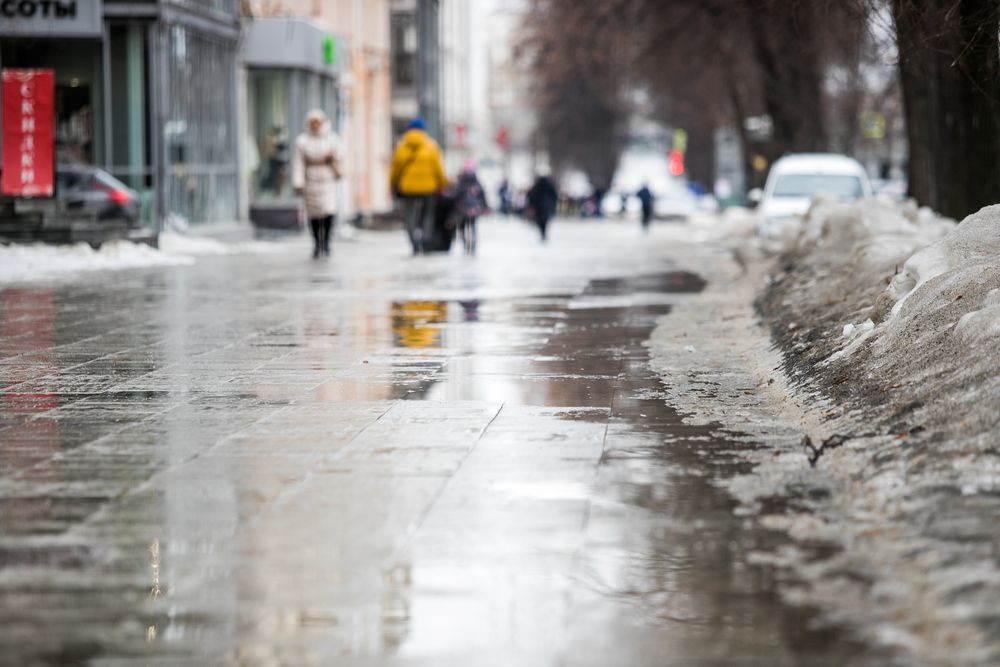How to Melt Ice on Sidewalks & Walkways for Businesses

Winter weather can create hazardous conditions on commercial sidewalks and walkways, impacting the safety and accessibility of your property. Effective ice management is crucial to prevent slips and falls, ensuring that your business remains operational and safe for employees, clients, and visitors. This guide provides practical tips and methods specifically designed for commercial properties to keep your walkways clear and safe during the icy months.
Why Your Business Walkways Should Be Ice-Free
Maintaining ice-free walkways is essential for the safety, accessibility, and professionalism of any commercial property. Here are the key benefits of keeping your business walkways clear of ice, as well as the potential consequences of neglecting ice management:
Benefits of Maintaining Ice-Free Walkways
- Safety: Ensuring walkways are free of ice reduces the risk of slips and falls, protecting employees, clients, and visitors from potential injuries.
- Accessibility: Clear walkways allow easy access to your business, ensuring that everyone, including those with mobility issues, can enter and exit your property safely.
- Professional Appearance: A well-maintained, ice-free walkway presents a clean and professional image of your business, demonstrating your commitment to safety and customer care.
- Legal Compliance: Proper ice management helps you comply with local safety regulations, reducing the risk of fines and legal issues related to accidents on your property.
Risks of Neglecting Ice Management
- More Accidents and Injuries: Icy walkways can lead to slips, falls, and serious injuries, resulting in potential lawsuits and increased insurance premiums.
- Legal and Financial Liabilities: Failing to maintain safe walkways can result in legal claims and financial liabilities if someone is injured on your property.
- Negative Impact on Business Operations: Accidents and accessibility issues can disrupt your business operations, leading to lost productivity and revenue.
- Damage to Reputation: Poorly maintained walkways reflect negatively on your business, potentially deterring customers and damaging your reputation.
By prioritizing ice management for your commercial property, you ensure a safe, accessible, and professional environment for everyone who visits your business.
Common Ice Melting Products
Understanding the different types of ice melting products available can help you choose the most effective solution for your commercial property. Each product has its own advantages and is suited to specific conditions.
Rock Salt (Sodium Chloride)
Rock salt, or sodium chloride, is one of the most common and affordable ice melting options. It works by lowering the freezing point of water, effectively melting ice. However, rock salt is most effective at temperatures above 15°F (-9°C) and can be harsh on concrete and vegetation if overused.
Calcium Chloride
Calcium chloride is another popular choice, known for its ability to work in very low temperatures, down to -25°F (-32°C). It acts quickly and lasts longer than rock salt, making it a reliable option during harsh winter conditions. When used properly, calcium chloride is safe for concrete and less damaging to vegetation.
Magnesium Chloride
Magnesium chloride is effective at temperatures as low as -13°F (-25°C) and is considered more environmentally friendly compared to other ice melts. It is less harmful to plants and concrete, making it a preferred choice for properties concerned with minimizing environmental impact.
Alternative and Eco-Friendly Solutions
In addition to these traditional ice melts, there are alternative and eco-friendly solutions available. Sand can be used to provide traction on icy surfaces, although it does not melt the ice. Homemade ice melt solutions, such as a mixture of water, rubbing alcohol, and dish soap, can also be effective for small areas. Pet-safe and environmentally friendly products are designed to minimize harm to pets, plants, and the environment while still providing effective ice melting capabilities.
Best Practices for Commercial Sidewalks and Walkways
Ensuring that your commercial sidewalks remain ice-free during the winter months requires a combination of effective strategies and proper application techniques. Here are some best practices to keep your sidewalks safe and accessible.
Pre-treatment is a crucial step in preventing ice formation on sidewalks. Applying ice melt products before a storm can create a protective layer that reduces the adherence of ice to the surface. Brine solutions, which are mixtures of salt and water, are particularly effective as a pre-treatment, helping to prevent the formation of ice and making it easier to remove once the storm passes.
Effective application techniques are essential for maximizing the efficiency of ice melt products. It’s important to spread the ice melt evenly across the sidewalk surface to ensure comprehensive coverage. Using a spreader can help achieve an even distribution, preventing concentrated areas that could lead to damage. Following the manufacturer’s instructions regarding the amount and method of application is crucial for optimal results.
Combining sand with ice melt products can provide additional traction on icy surfaces, making sidewalks safer for pedestrians. While sand does not melt ice, it offers a temporary solution by increasing grip and reducing the risk of slips and falls. This combination is especially useful in extremely low temperatures where traditional ice melts may be less effective.
Regular monitoring and maintenance are vital to ensure the continued safety of commercial sidewalks. During and after a storm, it’s important to reapply ice melt products as needed, especially in high-traffic areas. Regularly clearing snow and ice from sidewalks helps prevent the buildup that can lead to more hazardous conditions.
Great Lakes Snow Keeps Your Business Winter Safe
Ready to keep your business walkways safe and ice-free this winter?
Contact Great Lakes Snow for
professional snow and
ice management services in the
Chicagoland area.
Our team of experts is dedicated to providing reliable and efficient solutions tailored to your commercial property needs.
- Phone: 1-847-742-7669
- Address: 1426 Davis Rd., Elgin, IL 60123


